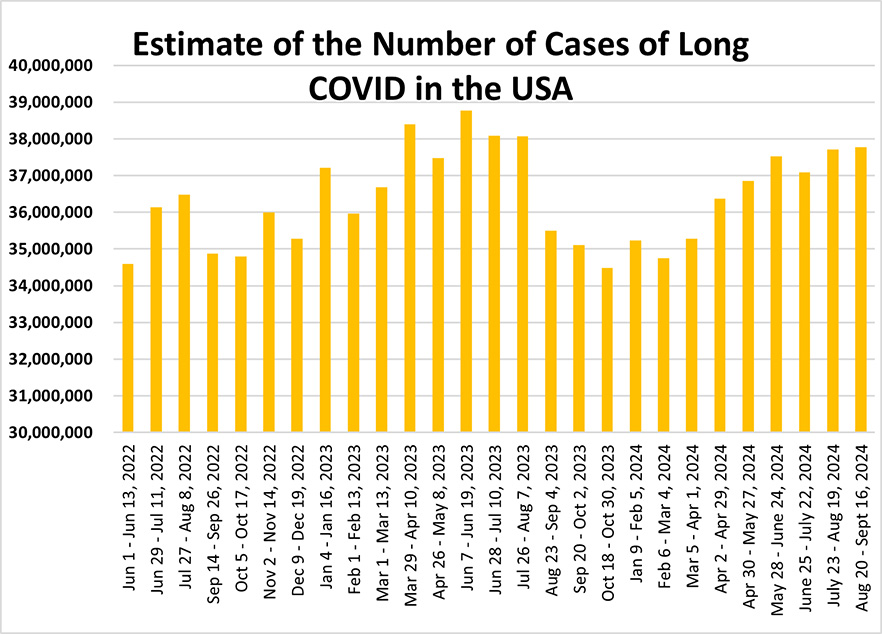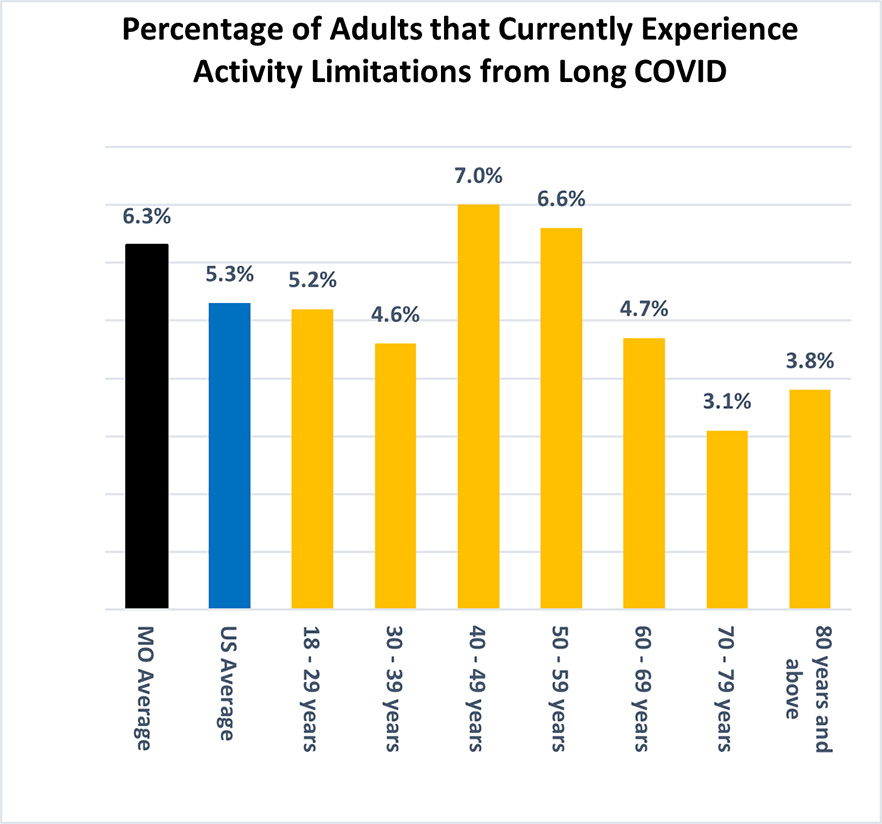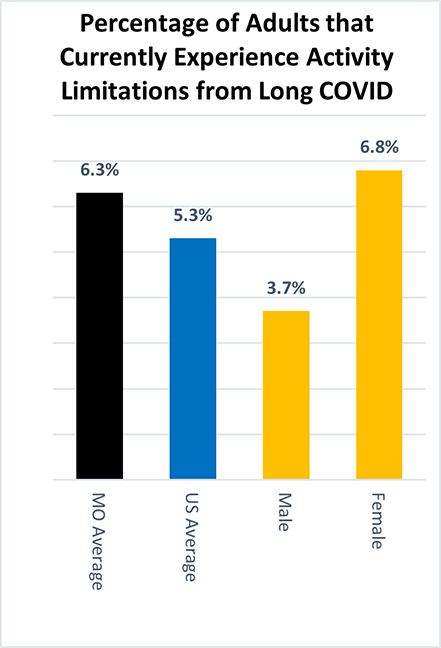Society is looking to move beyond the pandemic years; however, many Missourians still suffer from the effects of COVID-19, even if they did not develop a severe case of COVID-19. This publication will explore the implications of Long COVID and its impact on workers. After addressing the health implications, educational resources will be shared.
What is Long COVID?
One of the under-realized impacts of COVID-19 is Long COVID, at times referred to as Post COVID syndrome and COVID-19 conditions, which is defined by the CDC (2023) as new, returning, or ongoing health issues affecting multiple organ systems for at least four weeks after a confirmed or suspected COVID-19 infection. Although the presentation of Long COVID varies by person, a commonly-noted symptom is excessive tiredness – a prominent symptom of chronic fatigue syndrome (CFS), another potential post-viral illness. Other reported symptoms of Long COVID are joint pains, shortness of breath, changes to taste and smell, and brain fog. Individuals with Long COVID are sometimes called “Long haulers” (Steele, 2023).
How many people have Long COVID?
The US Census Bureau regularly surveys individuals via the Household Pulse Survey and tracks self-reported cases of Long COVID. The September 2024 Household Pulse Survey estimated that 742,000 Missourians have at one point experienced Long COVID-19. Currently, 269,000 Missourians are experiencing limitations, of which 61,000 cannot conduct day-to-day activities.

Figure 1 shows an estimated 37.8 million people have experienced the effects of Long COVID, or 1 in 7 people. A Brookings Report from 2022 estimated that Long COVID has potentially reduced the size of the national workforce by two to four million people. More recently, the Wall Street Journal reported that more than two million prime-age workers have altered their career trajectory due to limitations caused by Long COVID. A potential reduction of two to four million workers (1-2%) in the size of the workforce will make a tight labor market even tighter while simultaneously contributing to a greater demand for medical services.
Implications for the labor market

Looking at the September 2024 data from a labor market perspective can give us better insight into what portion of the workforce is impacted by Long COVID. The data in Figure 2 indicates that approximately 7% (6.2 – 7.8%) of the population between the ages of 40 and 49 face limitations due to Long COVID. This means that one out of 14 people in their peak productive years are experiencing physical, cognitive, or psychological restrictions. Looking at Figure 3, the national average impact is 5.3% of all adults (13.6 million people) who are estimated to be experiencing limitations due to long COVID. Missouri is slightly worse, with 6.3% of adults, or 296,000 people, facing the same restrictions. These physical and cognitive limitations will not improve productivity in the workplace, and individuals with more severe and persistent cases of Long COVID will need to change jobs, reduce hours, retire, or apply for disability.

As seen in Figure 3, women are more likely than men to be negatively impacted, 6.8% of all adult females vs. 3.7% of adult males. This means that for every four males with Long COVID, seven females are suffering from Long COVID. A more detailed breakdown of the demographic data is available at the Center for Disease Control. Reducing the workforce's health will only make the labor market more challenging for employers. It is important to note that other demographic factors also limit the workforce size as baby boomers retire, and Missouri's population growth has slowed. These combined factors mean that employers will need to think about how best to accommodate current and future employees who have a disability or who are suffering from the effects of Long COVID. The days of a surplus workforce are in the past.
Treatment and health outcomes
The treatment prospects for workers with persistent Long COVID are limited because doctors and researchers are still trying to understand the causes of Long COVID so that they can develop a treatment strategy. The Household Pulse Survey Report stated: "that many people may have lifelong disabilities as a result [of Long COVID). Among people who currently have Long COVID, many have trouble accessing the health care they need. Patients often visit many specialists before getting a diagnosis and, when they have a diagnosis, struggle to find a provider on account of provider shortages. Providers themselves wrestle with uncertainty regarding the course of treatments most likely to help. Among people with activity limitations who are unable to work, many have trouble accessing disability benefits through their workplaces or federal disability insurance programs."
Due to its novel and widespread nature, Long COVID patients are banding together and creating networks of support and resources to help each other better manage their health and give themselves the tools to better navigate a healthcare system with limited diagnostic tools and treatments. Given the limited understanding of the condition, some patients may choose to advocate, join communities of support, and educate themselves through books and podcasts.
Resources
This publication explored the nature and scale of Long COVID and its far-reaching effects on workers and businesses. While treatments are still being explored, the following section shares informational resources, podcasts, and books. Future publications will address the legal implications of Long COVID and the best practices that employers can implement to support workers better.
Long COVID
Videos PBS Reports
Economic Costs of COVID-19 and Long COVID
Supporting Employees with Long COVID
- How Managers Can Support Employees With Long COVID
- Working with Long COVID: research evidence to inform support
Managing Long COVID Podcasts
Books:
Support Groups:
References
Bansal, R., Gubbi, S., & Koch, C. A. (2022). COVID-19 and Chronic Fatigue Syndrome: An Endocrine Perspective. Journal of Clinical and Translational Endocrinology, 27.
Burns, A. (2023, January 26). Long COVID: What Do the Latest Data Show? KFF.
Calfas, J., & Overberg, P. (2024, August 27). Long Covid Knocked a Million Americans Off Their Career Paths. Wall Street Journal (Online), N.PAG.
CDC. (2022, June 22). Nearly One in Five American Adults Who Have Had COVID-19 Still Have “Long COVID.”
CDC. (2022, July 19). Long COVID - Household Pulse Survey - COVID-19.
CDC (2023, July 20). Long COVID or Post-COVID Conditions. Center for Disease Control and Prevention. Retrieved August 23, 2023.
Chippa, V., Aleem, A., & Anjum, F. (2023, February 3). Post-Acute Coronavirus (COVID-19) Syndrome. National Center for Biotechnology Information. Retrieved August 23, 2023.
Household Pulse Survey. (n.d.). census.gov. Retrieved July 25, 2023.
Ohler, A., & Dietterle, L. (2022, October 24). Missouri Economy Indicators COVID-19 and Paid Leave. MU Extension.
Steele, R. W. (2023, March 3). Long Coronavirus 2019 (COVID-19). Emedicine. Retrieved August 23, 2023.
What the Latest Research Tells Us About Long COVID’s Most Common Symptoms. (n.d.). PBS News Hour. Retrieved July 25, 2023.